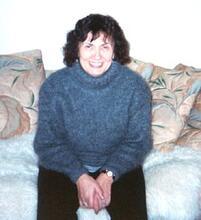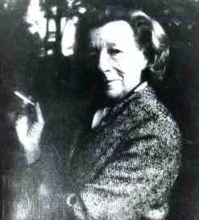Pauline Podbrey
Pauline Podbrey, a Jewish immigrant from Lithuania, arrived in South Africa as a young girl with her parents in the 1930s. Inspired by her politically left-wing parents and their associates, Podbrey’s teenage years were spent involved in trade union affairs and anti-Apartheid activities. She married the militant Indian Communist H.A Naidoo. Years of hardship under Apartheid followed their interracial, and later unlawful, marriage. The couple were forced to flee South Africa with their young family. In exile, they became irrevocably disillusioned with Communism, as Podbrey recounted in her well-known autobiography, White Girl in Search of the Party. Podbrey’s Jewishness remained important throughout her life and was frequently cited as an influential factor in her activism. She died in 2009, having returned to South Africa following the fall of Apartheid.
From Lithuania to South Africa
Pauline Podbrey was born Pessel Podbrez in the shtetl of Malat in Lithuania in 1922. She spent her early years steeped in the Orthodox Judaism of her observant grandmother’s home. Podbrey’s father was a Yiddish teacher and a committed member of the Bund (the Socialist Jewish Workers’ party) who left Kovno for South Africa in the late 1920s, a time of worldwide economic depression. While her early education was in Yiddish and Hebrew, Podbrey’s father was an atheist and religious ritual played no part in the Podbrey family.
Podbrey and her mother joined her father in South Africa in 1933, at which time the family’s surname was anglicized and Pauline lost her Yiddish given name. The Podbreys settled in Durban, Natal (now KwaZulu), where Podbrey’s younger brother Maurice was born. Apart from an uncle and an aunt, Podbrey’s entire extended family perished in the Holocaust.
In South Africa, Podbrey’s parents took on new roles: her father became a bookkeeper, and her mother set up various small but successful businesses. They were soon embraced by a close-knit circle of left-wing intellectuals of varying faiths and color, almost all of whom were members of the Communist Party of South Africa. Along with the powerful influence of her fervent father, this community was to have a significant impact on Podbrey’s political identification. As a very young girl in Lithuania, Podbrey had regretted the absence of Jewish ritual in her parents’ home. In South Africa, she found her religious yearnings replaced by a faith in Communism and a place in that political community. Despite being an able student, she left school at sixteen to begin work in the Party’s trade union department.
Working for the Communist Party
When Podbrey joined the Communist Party of South Africa (CPSA) in 1939, it was the only political party in South Africa that accepted members of all colors. Jews were not discriminated against, and indeed were disproportionately represented. However, there was no sense of Jewishness in the CPSA, and many of its members took pains not to be identified as Jewish. Throughout her life, Podbrey spoke out against this phenomenon, insisting that her Communist sympathies were rooted in Jewish ethics and Jewish morality, in a sense of justice and a reverence for the past. Deeply influenced by the Holocaust, in which many members of her extended family had been lost, she felt that it was an obligatory part of the Jewish tradition to defend all who suffered oppression.
When Podbrey married H.A. Naidoo, a Communist Party leader and militant trade unionist of Indian descent, in 1950, her family was snubbed by its Jewish friends. Podbrey and Naidoo left Durban for Cape Town, assuming that the Cape Province (originally the old “British” part of South Africa) would be less hostile to a mixed-race couple than other provinces of South Africa. However, racial separation had been integral to British colonialism. The immigration of Indians (and others considered “Non-White”) to South Africa had been outlawed in the 1920s, and Jewish immigration curtailed by the Quota Act of 1930 and the Aliens Bill of 1937.
Life Under Apartheid
Once the Nationalist Party was elected in 1948, Apartheid (racial separation) became institutionalized in South Africa. The Prohibition of Mixed Marriages Act (Act No 55 of 1949) and the Immorality and the Suppression of Communism Acts of 1950 banning the CPSA tore Podbrey’s young family apart. Naidoo, an unrepentant Communist, was forced into home confinement in Durban, 1600 kilometres away from his home with Podbrey and their daughters Karen and Sandra in Cape Town.
At this time of grave hardship, Podbrey and her daughters were not supported by the local Jewish community. Despite the initially warm welcome Podbrey received from the school principal when she went to enrol her “mixed-race” daughters at the Jewish school in Cape Town, the school board (chaired by Chief Rabbi Prof. Israel Abrahams of The Great Synagogue, Cape Town) refused to allow the children to attend, arguing that their enrolment would threaten the school’s government licence. This ruling was supported by a significant proportion of the school’s parent body.
Escape Overseas
Ultimately, increasingly stringent Apartheid legislation made life in South Africa untenable for the Naidoos. They were denied passports, and therefore any legal route to exit. With the help of the CPSA, they escaped to London in 1951. The British Communist Party sent them to work as radio broadcasters in the English service of Radio Budapest. They were to promote the Communist cause in the Cold War battle of the 1950s. Their time in Communist Hungary proved challenging, and both Podbrey and Naidoo began to question their faith in Communism. Their earlier Marxist beliefs floundered in the face of the gritty reality of Socialist life in Hungary and the many reports of crimes committed in Stalin’s name. Podbrey was also shocked to find that antisemitism and socialism could co-exist. Thoroughly disillusioned, the couple gave up their posts, resigned from the Communist Party, and returned to England, where their third daughter Jennie was born. Shunned by his former party members, Naidoo suffered from devastating bouts of depression. Until his untimely death in 1971, he was completely dependent upon Podbrey and unable to contribute to family life. Podbrey was forced to work as a teacher of shorthand and typing, while studying and raising their young family of three daughters.
Anti-Apartheid Activities
Podbrey had become involved with the anti-Apartheid movement (AAM) soon after it was founded in Britain in 1960. The Sharpeville massacre in Johannesburg had drawn the world’s attention to Apartheid, and anti- Apartheid activism began in earnest. In 1990, following the unbanning of the ANC, Podbrey returned to South Africa with her second husband, Terry Callaghan. Her daughters remained in England, making sporadic visits to South Africa to visit family. Her eldest daughter Sandra, who married the musician Tony Ashton, became one of the first mixed-race TV news presenters in London.
Pauline Podbrey died in Cape Town in 2009. The legacy of her involvement in social causes continues today through the Pauline Podbrey Foundation, which was established by her brother Maurice in 2011 and supports disempowered youth in the Khayelitsha township of Cape Town. A well-regarded theatre director in Canada, Maurice returned to South Africa to set up the foundation, saying that he could think of no better way to pay tribute to his much admired, brave, and generous sister.
Podbrey, Pauline. White Girl in Search of the Party. Kwa-Zulu: Hadeda Books, 1993.
Saunders, Blair Dickman. Conflict of Color: White Activists in the South African Anti-Apartheid Movement. Undergraduate thesis, College of William and Mary, 2011.
Scanlon, Helen. Representation and Reality: Portraits of Women’s Lives in the Western Cape, 1948-1976. Cape Town: HSRC Press, 2007.
Shimoni, Gideon. Community and Conscience: The Jews in Apartheid South Africa. Glosderry: David Philip Publishers, 2003.
Suttner, Immanuel. Cutting Through the Mountain: Interviews with South African Jewish Activists. Johannesburg: Viking, 1997.











